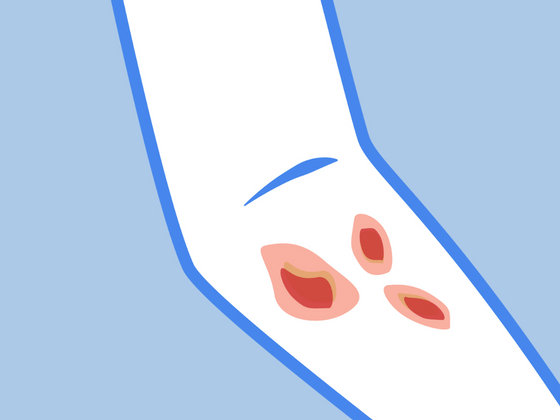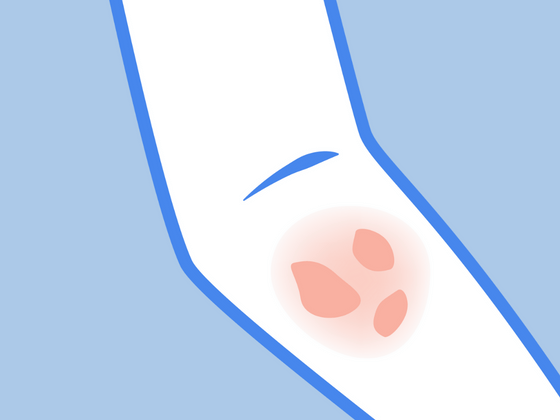Topical Steroid Withdrawal (TSW) - also known as Red Skin Syndrome (RSS) or Topical Steroid Addiction (TSA) is a sensitive and controversial topic but an important one. Although there is research that both discourages and supports the use of topical steroids, the bottom line is that Topical Steroid Withdrawal is real. It exists.
Over the last few years, the subject has received heightened attention resulting in an increase in misconceptions surrounding the condition. This has also led to fear among patients and parents of patients due to the rapid spread of information (and misinformation) made easier by social media and the internet.
If you’ve ever experienced an irritable skin condition, such as an eczematous rash or eczematous skin, chances are that you’ve probably been prescribed topical steroids as a form of treatment. And why not? Hailed for over three decades as an effective form of medication, they’re universally recognized as a safe method to treat inflammatory diseases - but what happens when the use of topical steroids stops and symptoms of “withdrawal” appear?
Read on to learn more about the causes, symptoms, and treatment options that are available for those suffering with the condition.
Note: If you’ve been suffering from TSW, or TSA please bear in mind that we are in no way medical professionals and while our suggestions may provide relief, this condition requires medical intervention to avoid infection and you should always speak to a medical professional before making any lifestyle or dietary changes.
What is Topical Steroid Withdrawal?
Topical Steroid Withdrawal - also known as Red Skin Syndrome (RSS) or Topical Steroid Addiction (TSA) - is a term used to describe the bodily symptoms that occur when long-time users stop or reduce the application of topical steroids. It’s a painful and debilitating condition. Imagine itchiness, a burning sensation, red and inflamed skin.
TSW is based around the concept of steroid addiction – meaning that extended use of steroids decreases their effectiveness over time and that skin may appear to worsen rather than improve as a result.
As with any form of “addiction,” quitting the use of something that was once used regularly or on a daily basis over a prolonged time, may result in symptoms of withdrawal. In the case of topical steroid usage, expected symptoms include:
- Red sunburnt-like skin
- Visible flaking of skin
- Oozing skin
- Red sleeves (arms or legs become red and inflamed)
- Body temperature changes
- Hypersensitivity of skin to water
- Enlarged lymph nodes
- Hair loss
- Insomnia
- Fatigue
- Depression, anxiety, and mood changes
Who is at Risk? The risk for topical addiction is greater if you’ve been on topical steroids for longer than two weeks without a break. Bear in mind that TSW is an iatrogenic condition meaning that it’s caused by the use, or misuse, of medication. Therefore, it’s extremely important to talk to your doctor about learning to use steroids properly with the required break between two week doses or weaning yourself off the medication all together. To the horror of many parents, children are unfortunately at a higher risk for TSW and sadly, may suffer greater discomfort due to their lower pain thresholds. Finding appropriate eczema cream for babies becomes especially important during withdrawal.
As mentioned earlier, there are plenty of misconceptions floating around regarding this condition. Dr. Peter Lio, co-founder and co-director of the Chicago Integrative Eczema Center, has been studying TSW and treating patients suffering from TSW for many years and offers valuable insights into the myths and realities surrounding the condition in this blog post: Topical Steroid Withdrawal: Myth vs. Reality.
Topical Steroid Withdrawal Treatment
With any debilitating condition, it’s crucial to seek medical advice as soon as possible. Unfortunately, as of yet, there is no golden method of treatment that can cure the symptoms of Topical Steroid Withdrawal quickly and successfully. However, there are plenty of pain/itch management strategies that can be employed to relieve the pain. Generally, stopping the usage of topical steroids ‘cold turkey’ is rare. Most doctors will wean a patient off the steroids gradually and with expert supervision.
Here are some management strategies to help relieve your pain:
Eliminate Triggers
This is perhaps the most crucial step to relieving eczema. From airborne allergens (such as pollen, dust and grass) to fabric irritants (such as latex, polyester and nylon) there are no shortage of eczema triggers. Diet typically plays a huge role as well. To find your food triggers, try an eczema elimination diet. Be sure to work with a nutritionist, especially when children are involved, to ensure you retain all essential nutrients.
Moisturize and Hydrate
Red, itchy skin is a prime symptom of Topical Symptom Withdrawal or Topical Symptom Addiction. To find relief from the itch-scratch cycle, we prefer to use eczema cream made from natural ingredients such as this Organic Manuka Skin Soothing Cream. You can enjoy this cream in combination with our Coconut and Sunflower Oil Soap by trying our Body Essentials Bundle. It's the perfect treatment for soothing and smoothing sensitive skin.
Containing olive oil, beeswax, manuka oil, manuka honey, filtered water, and grape seed oil, it hydrates even the driest of skins. Soft and creamy, it’s sure to soothe your skin without any stinging or burning. Bonus points: it’s also anti-bacterial and heals wounds!
Don’t Scratch
Easier said than done, we know. But luckily there are some preventative measures you can take to protect your skin from yourself. For intense relief, cool your skin with a cold compress to help numb the area and reduce the itchiness. You might also consider Remedywear, Clothing for Eczema. All clothing is made with TENCEL and anti-inflammatory zinc fabric to reduce inflammation and itching. Sinking into a warm bath full of oatmeal will also help rehydrate and soothe your skin.
Speak with your physician before taking any action
We do not recommend taking your child off steroids without first consulting medical help. It is in your best interest to educate yourself as much as possible about TSW or Topical Steroid Addiction and the risks involved with weaning yourself off topical steroids. This article, Understanding Topical Steroid Withdrawal is a good read.
Coping Strategies
The side effects of Topical Steroid Withdrawal are numerous and worrying, affecting the physical, mental, and emotional well-being of patients. These include, but are not limited to, depression, anxiety, social withdrawal, and a downward spiral in self-confidence.
While navigating TSW certainly is a difficult journey, it is not one that you need to walk alone. Remember that seeking help from a therapist or psychologist to improve your mental health is just as important as visiting a medical doctor to better your physical health.
Are you struggling with Topical Steroid Withdrawal or Topical Steroid Addiction? Join our It’s an Itchy Little World Facebook group and share your story with others.
------------------

Bio: Laura is a contributor and content developer for The Eczema Company. She is in no way a medical professional. Her comments, suggestions, and reflections are not intended to replace any medical advice. Always seek the help of a medical professional before undertaking any diet or lifestyle changes.








